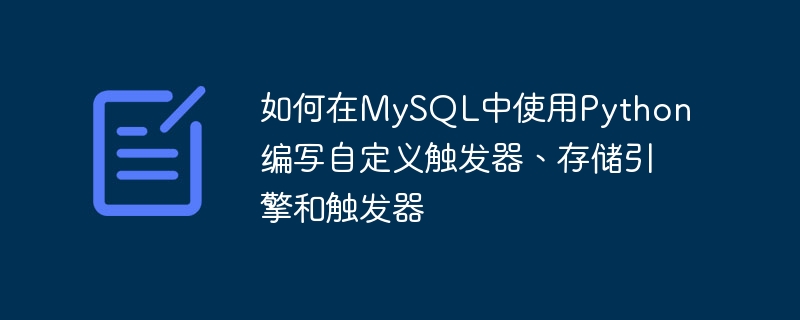

How to use Python to write custom triggers, storage engines and triggers in MySQL
Triggers are a special type in the MySQL database stored procedures. They are associated with a specific table and automatically trigger and execute some specific logic during the table's INSERT, UPDATE, or DELETE operations. Triggers are commonly used to enforce data integrity constraints, data validation, and perform complex data operations. MySQL database provides built-in triggers, but sometimes we may need to write custom triggers to meet specific needs. This article will introduce how to use Python to write custom triggers, storage engines and triggers, and provide specific code examples.
1. Writing a custom storage engine
Storage engines are one of the core components of the MySQL database and are responsible for storing and managing data. MySQL provides a variety of built-in storage engines, such as InnoDB, MyISAM, etc. Sometimes, we may need to write a custom storage engine to meet specific needs. The following is a simple sample code that demonstrates how to use Python to write a custom storage engine:
import mysql.connector
from mysql.connector import errorcode
def create_engine(cursor):
try:
# 创建一个新的存储引擎
cursor.execute("CREATE TABLE my_engine ();")
cursor.execute("SHOW ENGINES;")
rows = cursor.fetchall()
for row in rows:
if row[0] == 'MY_ENGINE':
print('Custom engine created successfully.')
break
except mysql.connector.Error as err:
if err.errno == errorcode.ER_TABLE_EXISTS_ERROR:
print('Table already exists.')
else:
print('Error creating engine:', err.msg)
def drop_engine(cursor):
try:
# 删除自定义存储引擎
cursor.execute("DROP TABLE my_engine;")
print('Custom engine dropped successfully.')
except mysql.connector.Error as err:
print('Error dropping engine:', err.msg)
def main():
try:
# 连接到MySQL数据库
cnx = mysql.connector.connect(user='root', password='password',
host='localhost',
database='my_database')
cursor = cnx.cursor()
# 演示创建和移除存储引擎
create_engine(cursor)
drop_engine(cursor)
# 关闭数据库连接
cnx.close()
except mysql.connector.Error as err:
print('MySQL Error:', err)
if __name__ == "__main__":
main()2. Writing custom triggers
Triggers can automatically perform some specific actions on tables in a MySQL database. logic to implement data integrity constraints, data validation, or perform complex data operations. Below is a sample code that demonstrates how to write a custom trigger using Python:
import mysql.connector
from mysql.connector import errorcode
def create_trigger(cursor):
try:
# 创建一个新的触发器
cursor.execute("CREATE TRIGGER my_trigger BEFORE INSERT ON my_table FOR EACH ROW "
"BEGIN "
"IF NEW.column < 0 THEN "
"SIGNAL SQLSTATE '45000' SET MESSAGE_TEXT = 'Invalid value'; "
"END IF; "
"END;")
print('Custom trigger created successfully.')
except mysql.connector.Error as err:
if err.errno == errorcode.ER_SP_ALREADY_EXISTS:
print('Trigger already exists.')
else:
print('Error creating trigger:', err.msg)
def drop_trigger(cursor):
try:
# 删除自定义触发器
cursor.execute("DROP TRIGGER IF EXISTS my_trigger;")
print('Custom trigger dropped successfully.')
except mysql.connector.Error as err:
print('Error dropping trigger:', err.msg)
def main():
try:
# 连接到MySQL数据库
cnx = mysql.connector.connect(user='root', password='password',
host='localhost',
database='my_database')
cursor = cnx.cursor()
# 演示创建和移除触发器
create_trigger(cursor)
drop_trigger(cursor)
# 关闭数据库连接
cnx.close()
except mysql.connector.Error as err:
print('MySQL Error:', err)
if __name__ == "__main__":
main()The above is a brief example of how to use Python to write custom triggers, storage engines, and triggers in MySQL. Based on actual needs, you can modify and extend these sample codes to meet your specific needs. Please make sure that before using custom triggers and storage engines, you have understood the relevant documentation and guides for the MySQL database and are familiar with the basics of the Python programming language. I wish you success in writing custom triggers and storage engines!
The above is the detailed content of How to write custom triggers, storage engines and triggers in MySQL using Python. For more information, please follow other related articles on the PHP Chinese website!




